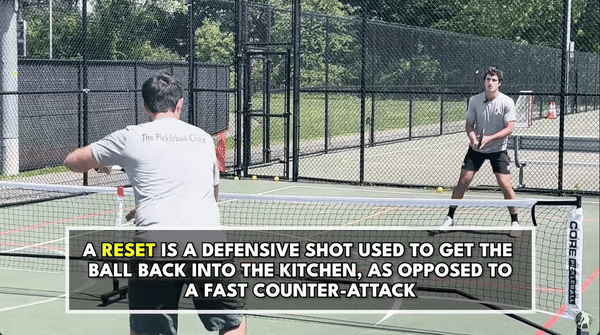
Welcome to The Pickleball Clinic Coaching Newsletter!
There are some skills in pickleball that you need to be good at, even though you probably want to avoid using them as much as possible.
One of these skills is playing in the transition zone.
The transition zone is arguably the most difficult area of the court to master playing in, and at the amateur level, the majority of points are won or lost there.
Today, we’re going to take a look at key strategies to help you tackle the transition zone, so you can get to the kitchen line with confidence.
Let’s dive in 👇

In a coaching video recently posted to our YouTube, Ben Johns wisely said “if you’re not getting to the net safely… you’re probably not doing a lot of winning.”
I couldn’t agree more!
However, in order to get to the kitchen line, and hold your ground once you’re there, you need to get through the transition zone first. This area of the court presents a lot of trouble for amateur players.
📖 The transition zone, or “no man’s land,” is the area between the baseline and the kitchen line. It’s called the transition zone, because you cross through it as you transition from the baseline to the kitchen.
The transition zone is the most difficult are of the court to play in, because most shots that come to you will be bouncing by your feet. Yet, it’s incredibly important to learn to play the transition zone, because you can’t get to the kitchen without crossing through it first.
The key is to attack less and reset more. When caught in the transition zone, your reset is your best friend. Since most shots that come to you in the transition zone will be low, trying to attack will get you into trouble. Therefore, putting the ball in the kitchen will neutralize your opponents’ advantage and allow you to move up to the kitchen. (That being said, if you do get a shot that you can contact above the net, feel free to attack.)

Here are the keys to playing great transition zone defense. These tips will help you keep the ball low so your opponents can’t continue their attack:
Keep a wide, low base. You can’t defend shots from your feet if you’re standing upright!
Eliminate your swing. Hold the paddle out in front and let the ball deflect off your paddle and back into your kitchen. If you swing, the ball will popup and you’ll open yourself up to a slam. You should look to absorb the pace of your opponent's shot, and hit the ball as soft as possible.
Stop when your opponent hits and set your feet. It’s very difficult to reset while you’re moving for a couple reasons. First, if you’re moving the shot will be harder to time, and you’re likely to have a mishit. Second, even if you do contact the ball well, your forwards momentum will apply additional power and cause the ball to pop up.
Finally, after you hit your shot either move up or get back, but don’t stay in transition. You should never hit from the same spot twice when you’re in the transition zone. If you hit a good reset, move forward towards the kitchen. If you hit a bad reset, get back behind the baseline and get ready to defend. This goes back to our first point: that there are some skills in pickleball that we need to have, even though we don’t like to use them.
💡 Most points at the amateur level are won or lost in transition.
Just being able to play the transition zone effectively and get to the kitchen safely will have a massive impact on your game!
Try this out next time you play and let us know if you see the results.
See you on the courts!
- Matt Slowinski (Co-Founder, Pro Player & Coach)


Ready for a reset masterclass? Watch this! 👇
Notice the effort to put the ball back into the kitchen from the team on the near side as soon as they got in trouble. The resets were hit with a low, steady base and with no swing. Plus, after each shot both players either moved forward or backwards to get out of the transition zone. No shots were hit from the transition zone twice in a row! 💪


Insights from Pickleball Pro, Coach, and Creator Tanner Tomassi
The key to defense in the transition zone is 2 main things. When you break it down, it’s pretty simple to master!
1. Paddle ready position. Your paddles ready position should be in correlation to where you are on the court. If you’re in the mid court, your paddle should be at about knee height. The reason is, anything above that, is out, so already be where the ball can only go!
2. You want to think of the analogy when a pitcher throws a fastball at a catcher. The catcher absorbs the pitch with his elbow in contact, he does not keep his elbow stiff and locked. Same exact concept here. You want to use yours opponents power against them, instead of trying to create your own!


Enough reading about transition defense - it’s time to get out on the court and practice it for real!
Here’s a drill that will help you master transition zone resets, so you can become a defensive weapon on the court.
7-11 Reset Game
Grab a partner and set up with one player at the kitchen line and one player in the mid court, about 4 feet inside the baseline. This drill will be done using half the court.
The player in the mid court feeds the kitchen player a shoulder high, attackable volley. The player at the kitchen should attack this ball.
The player in the mid court attempts to reset from the transition zone, then play the point out. If the reset is high, back up to the baseline and continue to defend. If the reset is low, continue up to the kitchen.
After each point, continue in the same position until the kitchen player scores 11 points or the transition player gets 7 points. (This scoring format neutralizes the kitchen player’s advantage.)
After each game, switch roles. After both players have had the chance to be both the kitchen and transition player, try it from the other half of the court, then try it cross court.

Having visual cues are a huge key to success when it comes to improving at any sport. 🔑 So, if you’re looking to get better, there’s no better place to go than our YouTube channel! Matt does awesome coaching videos that compliment many of the topics discussed in this newsletter, and Aaron hosts insightful interviews with the top pros. Subscribe today and start unlocking your full potential!

Well, that’s a wrap… so let’s recap what we learned this week about transition defense.
The reset is your best friend when playing in the transition zone. Playing soft should be your default setting.
Keep a low base and stop before you hit to minimize the chance of your momentum causing you to overhit.
Resets are hit with no forward swing. If you swing you will overhit!
After you hit from the transition zone, get out! Move up if your reset was good, or back if it was too high, but don’t stay in the transition zone for another shot.
Thanks for reading! We hope you can put these tips to good use the next time you’re out on the courts!
Reply to this email with anything you want to see in our future newsletters 😄
- Your Friends at The Pickleball Clinic


